
.
Giorgio di Giovanni, also known as Giorgio da Siena (active 1538 and died 1559), was an Italian painter of the Renaissance period, active mainly in Siena. [1]

.
Giorgio di Giovanni, also known as Giorgio da Siena (active 1538 and died 1559), was an Italian painter of the Renaissance period, active mainly in Siena. [1]
Little is known about the life of the painter. His works, for example the frescoes at the Castello di Belcaro, have also been attributed to Baldassare Peruzzi. Other works such as the Flight of Cloelia have been attributed to Domenico Beccafumi and Marco Bigio. Giorgio di Giovanni is known to have worked circa 1525–1530 on the Vatican Loggia in Rome along with Giovanni da Udine. [2]

The Sienese School of painting flourished in Siena, Italy, between the 13th and 15th centuries. Its most important artists include Duccio, whose work shows Byzantine influence, his pupil Simone Martini, the brothers Pietro and Ambrogio Lorenzetti and Domenico and Taddeo di Bartolo, Sassetta, and Matteo di Giovanni.
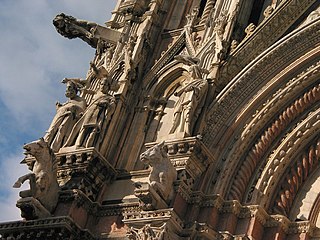
Giovanni Pisano was an Italian sculptor, painter and architect, who worked in the cities of Pisa, Siena and Pistoia. He is best known for his sculpture which shows the influence of both the French Gothic and the Ancient Roman art. Henry Moore, referring to his statues for the facade of Siena Cathedral, called him "the first modern sculptor".

Il Sodoma was the name given to the Italian Renaissance painter Giovanni Antonio Bazzi. Il Sodoma painted in a manner that superimposed the High Renaissance style of early 16th-century Rome onto the traditions of the provincial Sienese school; he spent the bulk of his professional life in Siena, with two periods in Rome.

Domenico di Bartolo, born in Asciano, Siena, was a Sienese painter who became active during the early Renaissance period. He was named by the famous painter, writer and historian Giorgio Vasari as the nephew of well-reputed Italian artist Taddeo di Bartolo, who is featured in Vasari's Lives of the Most Excellent Painters, Sculptors, and Architects. By the early 1400s, Domenico di Bartolo was one of Siena's artists most influenced by the new Florentine style of painting. During the time that he was active and working, Domenico was the only Sienese painter to have received commissions by clients in Florence. Domenico was also employed by Lorenzo Vecchietta, otherwise referred to as Lorenzo di Pietro, to work alongside him for the fresco The Care of the Sick, which is today considered a masterpiece of the Pilgrim's Hall in the hospital Santa Maria della Scala (Siena).

Francesco di Giorgio Martini (1439–1501) was an Italian architect, engineer, painter, sculptor, and writer. As a painter, he belonged to the Sienese School. He was considered a visionary architectural theorist—in Nikolaus Pevsner's terms: "one of the most interesting later Quattrocento architects". As a military engineer, he executed architectural designs and sculptural projects and built almost seventy fortifications for the Federico da Montefeltro, Count of Urbino, building city walls and early examples of star-shaped fortifications.

Sano di Pietro or Ansano di Pietro di Mencio (1405–1481) was an Italian painter of the Sienese school of painting. He was active for about half a century during the Quattrocento period, and his contemporaries included Giovanni di Paolo and Sassetta.
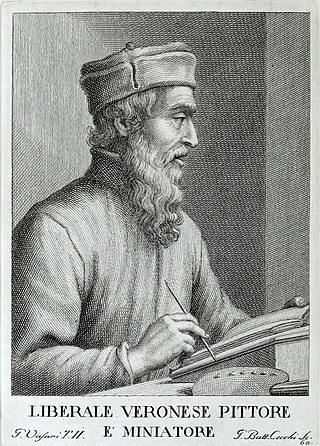
Liberale da Verona (1441–1526) was an Italian painter of the Renaissance period, active mainly in Verona.
Le Vite de’ Pittori, Scultori et Architetti. Dal Pontificato di Gregorio XII del 1572 in fino a’ tempi di Papa Urbano VIII nel 1642 is an art history book by Giovanni Baglione, first published in 1642. It represents an encyclopedic compendium of biographies of the artists active in Rome during late Mannerism and early Baroque. Baglione was a Late Mannerist and Early Baroque painter and art historian, best remembered for his writings and his acrimonious involvement with the artist Caravaggio, by whom he was nonetheless greatly influenced.

The Lives of the Most Excellent Painters, Sculptors, and Architects, often simply known as The Lives, is a series of artist biographies written by 16th-century Italian painter and architect Giorgio Vasari, which is considered "perhaps the most famous, and even today the most-read work of the older literature of art", "some of the Italian Renaissance's most influential writing on art", and "the first important book on art history".

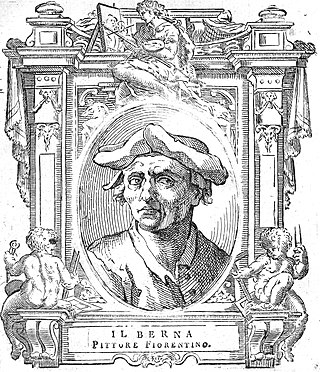
Barna da Siena, also known as Berna di Siena, was presumed to be a Sienese painter active from about 1330 to 1350.

Pietro di Francesco degli Orioli was an Italian painter of the Renaissance period.

Benvenuto di Giovanni, also known as Benvenuto di Giovanni di Meo del Guasta was an Italian painter and artist known for his choral miniatures, pavement designs, and frescoes. Working chiefly in Siena, he was first recognized to be working as an artist in 1453 and continued his work nearly until his death in approximately 1518. During his lifetime, he was influenced by many various artists and in the 1480s, Benvenuto's style changed drastically.

Andrea di Bartolo or Andrea di Bartolo Cini was an Italian painter, stained glass designer and illuminator of the Sienese School mainly known for his religious subjects. He was active between 1389–1428 in the area in and around Siena.
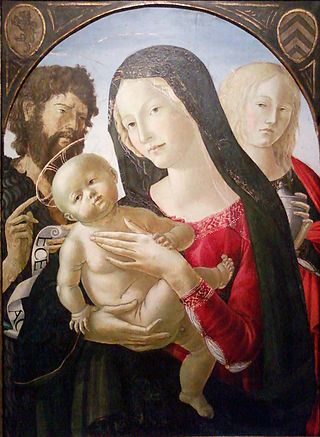
Madonna and Child with St. John the Baptist and St. Mary Magdalene is a painting by Neroccio di Bartolomeo de' Landi. The painting is a tempera on wood from 1495. It is currently held by the Indianapolis Museum of Art.
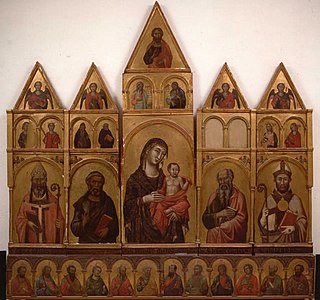
Mèo da Siena was an Italian painter active in Umbria in a late-Gothic style.

Michele Ciampanti was an Italian painter active mainly in Lucca. This painter has been identified as matching Berenson's putative Master of Stratonice, and is also called Michele di Michele Ciampanti.
The Master of Staffolo was an anonymous late-Gothic style painter active in the region of Marche and Umbria.
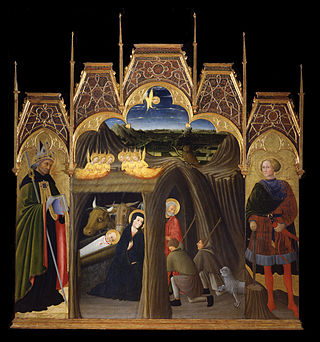
Pietro di Giovanni D'Ambrogio was an Italian painter of the Sienese school.